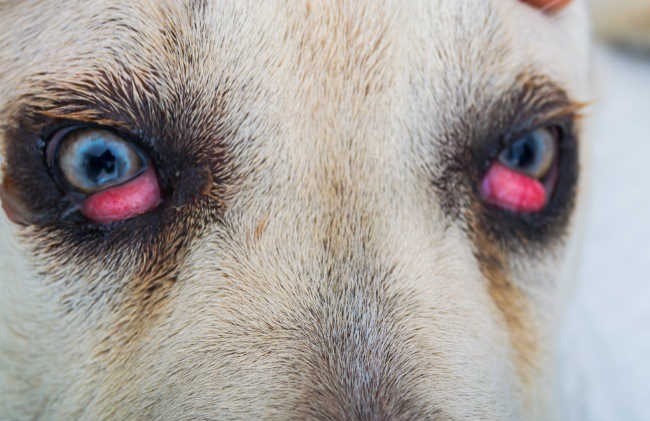Have you ever noticed something unusual in your Irish Setter’s eye? Perhaps a red or swollen mass that seems out of place? Well, chances are your furry friend may be experiencing a condition known as cherry eye in Irish Setter. This common ailment can affect our beloved Irish Setters and cause discomfort if left untreated.
Cherry eye, also known as nictitating gland prolapse, is a common condition that primarily affects certain dog breeds, including our beloved Irish Setters. It occurs when the tear gland located in the inner corner of the eye becomes swollen and visible, resembling a tiny cherry. While it may sound alarming, the cherry eye is not usually painful for your four-legged companion. However, if left untreated, it can lead to discomfort, eye irritation, and potential complications.
But fear not! In this article, we will delve into the world of cherry eye in Irish Setters, providing valuable insights on recognizing, preventing, and treating this condition. So grab a cup of tea, sit back, and let’s embark on this informative journey together.
Understanding Cherry Eye in Irish Setter
Cherry eye is a common eye condition affecting our beloved Irish Setters. As responsible pet parents, it’s crucial to understand this condition, its causes, and how we can prevent and treat it. Cherry eye refers to the third eyelid gland prolapse, leading to a visible red mass in the corner of your Irish Setter’s eye. This condition gets its name due to the resemblance of the protruding gland to a cherry. While it may sound alarming, cherry eye is generally not painful for your pet. However, if left untreated, it can lead to complications such as dry eyes and conjunctivitis.
Cherry eye is known to be more common in certain dog breeds, including Irish Setters. While it can occur at any age, it often presents itself in young dogs, usually between six months to two years old. So, if you have a playful Irish Setter puppy or a young adult, it’s essential to keep an eye out for any signs of cherry eye. By being aware of the prevalence and typical age of onset, we can take proactive steps to detect and address cherry eye early on, ensuring our furry friends stay happy and healthy.
What Causes of Cherry Eye in Irish Setters?

While Cherry eye in Irish setters may seem alarming, understanding the causes can help us prevent and address this condition.
➔Genetic factors:
Genetic predisposition is one of the leading causes of cherry eye in Irish Setters. Certain genes can make them more prone to this condition. It’s important to note that not all Irish Setters will develop cherry eye, but the risk is higher in those with a family history of the condition. Breeders play a vital role in preventing cherry eye by conducting proper health screenings and avoiding breeding dogs with a higher risk of passing on the genetic predisposition.
➔Weakness in connective tissue:
Irish Setters with weakened connective tissue are more susceptible to developing cherry eye. Connective tissues support the structures within the body, including the tear gland. When the connective tissue is weak, it fails to hold the gland in place, leading to its prolapse. Factors such as poor nutrition, inadequate exercise, and improper development can contribute to weakened connective tissue in Irish Setters. Ensuring a balanced diet, regular exercise, and overall good health can help strengthen their connective tissue and reduce the risk of cherry eye.
➔Underlying health issues:
Sometimes, cherry eye can be a symptom or result of underlying health issues in Irish Setters. Conditions like conjunctivitis, infections, allergies, or autoimmune diseases can cause inflammation and prolapse of the tear gland. Regular veterinary check-ups and prompt treatment of any underlying health issues can minimize the risk of cherry eye and improve the overall well-being of our furry friends.
➔Environmental triggers:
Certain environmental factors can trigger or worsen cherry eye in Irish Setters. Irritants such as dust, pollen, smoke, or chemicals can cause eye irritation and swelling, leading to the protrusion of the tear gland. Additionally, excessive rubbing or scratching of the eyes due to allergies or discomfort can also contribute to the development of cherry eye. By keeping our Irish Setters’ environment clean and free from irritants, we can reduce the likelihood of cherry eye occurrence.
By being aware of these causes, we can take proactive measures to prevent and address cherry eye, ensuring the well-being and comfort of our beloved Irish Setters.
Symptoms of Cherry Eye in Irish Setters
Recognizing the symptoms of cherry eye in Irish Setters is crucial for early detection and intervention. Below are some signs to look out for:
☑Red, swollen, or protruding third eyelid
One of the primary symptoms of cherry eye in Irish Setters is the appearance of a red, swollen, or protruding third eyelid. You may notice a small pinkish mass sticking out from the inside corner of their eye, resembling a cherry. This swollen gland can be easily visible and may cause concern for pet owners. It’s important to remember that this condition is typically not painful for our furry friends, but it can still lead to discomfort if left untreated.
☑Excessive tearing
Another symptom that may accompany cherry eye in Irish Setters is excessive tearing. You may notice increased tear production, leading to watery eyes and tear stains around the eye area. This can be bothersome for the dog and the owner, as it may require more frequent cleaning and maintenance. If you observe persistent tearing in your Irish Setter, it’s essential to investigate further and consult a veterinarian to determine the underlying cause.
☑Irritation and discomfort
Cherry eye can cause irritation and discomfort for our beloved Irish Setters. The protrusion of the tear gland can lead to rubbing, scratching, and pawing at the affected eye. Your furry friend may exhibit discomfort, such as excessive blinking, squinting, or avoiding bright lights. If you notice these behaviors, addressing the issue promptly is crucial to ensure your dog’s comfort and well-being.
☑Impact on vision and overall well-being
Cherry eye, if left untreated, can potentially impact your Irish Setter’s vision and overall well-being. The prolapsed gland can obstruct their field of vision or cause dryness and irritation due to inadequate tear production. If the condition persists, it can also lead to complications such as conjunctivitis or corneal ulcers. Regular veterinary care and early intervention are essential in preventing long-term consequences and preserving your furry friend’s visual health.
Understanding the symptoms of cherry eye in Irish Setters is vital for every pet owner. Recognizing the red, swollen, or protruding third eyelid, excessive tearing, irritation, and discomfort, and the potential impact on vision and overall well-being allows us to take proactive steps in seeking appropriate treatment.
Diagnosis and Veterinary Intervention in Irish Setters with Cherry Eye

For several reasons, obtaining a professional diagnosis for cherry eye in Irish Setters is essential. Firstly, a veterinarian has the necessary knowledge and expertise to evaluate the condition and provide a precise diagnosis properly.
This ensures that we distinguish cherry eye from other eye issues, allowing us to focus on the most effective treatment options. Additionally, a professional diagnosis helps us understand the severity of the condition and any potential complications that may arise, guiding us toward appropriate veterinary intervention.
Veterinary Examination and Diagnostic Procedures
During a veterinary examination for cherry eye, the veterinarian will thoroughly evaluate your Irish Setter’s eyes. They will observe the appearance of the eye, including any signs of redness, swelling, or protrusion of the third eyelid. Additionally, they may perform diagnostic procedures such as palpation, where they gently feel the affected area to assess the gland’s position and mobility. These examinations aid in confirming the diagnosis and determining the best approach for treatment.
Differentiating Cherry Eye From Other Eye Conditions
It is important to differentiate cherry eye from other eye conditions that may have similar symptoms. While cherry eye is characterized by the prolapse of the tear gland, other conditions such as conjunctivitis, corneal ulcers, or eye infections can also cause redness, swelling, and discomfort. The veterinarian will carefully examine the eye, consider the medical history, and may even conduct tests, such as eye swabs or cultures, to rule out other potential causes. Accurate differentiation ensures that we provide the most appropriate treatment for our Irish Setters’ specific condition.
Treatment Options for Cherry Eye in Irish Setters
The choice of treatment depends on the severity of the condition, the pet owner’s preference, and a veterinarian’s recommendation. Below are the non-surgical approaches, including medications, eye drops, massage, and manual repositioning.
💊Medications and eye drops:
One non-surgical approach to treating cherry eye in Irish Setters is using medications and eye drops. Veterinarians may prescribe anti-inflammatory medications or lubricating eye drops to reduce inflammation and alleviate discomfort. These medications reduce swelling and promote tear production, helping restore the gland to its normal position. It’s essential to follow the veterinarian’s instructions regarding dosage and frequency of administration for optimal results.
💊Massage and manual repositioning:
Another non-surgical method to address cherry eye is through massage and manual repositioning. This technique involves gently massaging and manipulating the affected area to encourage the tear gland to return to its original position. Pet owners can be guided by a veterinarian on proper massage techniques and how to reposition the gland carefully. This approach can be effective for mild cases of cherry eye and may provide relief without surgery.
💊Surgical Interventions
In more severe cases of cherry eye, surgical intervention may be necessary. Different surgical correction techniques are available, such as tacking or suturing the gland back into place. The surgical procedure involves creating a small incision and securing the gland with sutures or adhesive material to prevent further prolapse. The veterinarian will determine the most suitable technique based on the individual dog’s condition and anatomy.
Surgical intervention for cherry eye in Irish Setters has its pros and cons. On the positive side, surgery can provide a long-term solution, preventing the recurrence of cherry eye and minimizing the risk of complications associated with the condition. However, it is crucial to consider that surgery involves anesthesia and a recovery period, which may require monitoring and post-operative care. Additionally, there is a small risk of surgical complications, as with any procedure.
💊Post-surgery Care Guidelines
Following surgery for cherry eye in Irish Setters, it is crucial to adhere to the post-surgery care guidelines provided by your veterinarian. These guidelines may include administering prescribed medications, such as antibiotics or anti-inflammatory drugs, as instructed. Additionally, you may need to monitor the incision site for any signs of infection, inflammation, or discharge. It’s important to keep the area clean and follow any specific instructions regarding cleaning procedures or using warm compresses.
Moreover, in order to maintain long-term eye health in Irish Setters with a history of cherry eye, it is essential to establish a regular eye care routine. It includes gently cleaning the eyes with a damp cloth or specialized eye wipes to remove debris or tear stains.
Regularly examining the eyes for signs of redness, swelling, or discharge is also crucial. If you notice any changes or abnormalities, it is advisable to consult with a veterinarian promptly. Additionally, ensuring a balanced diet, providing adequate hydration, and avoiding exposure to irritants and allergens can contribute to overall eye health.
Home Care and Preventive Measures for Cherry Eye in Irish Setters

Taking care of our beloved Irish Setters at home is crucial in preventing and managing cherry eye, a common eye condition. Below are some practical home care tips and preventive measures that can help keep your Irish Setter’s eyes healthy and reduce the risk of cherry eye. By implementing these strategies, you can provide the best possible care for your furry friend.
📌Maintaining Good Eye Hygiene
Regularly cleaning the area around your Irish Setter’s eyes is essential to home care. Use a damp cloth or pet-safe wipes to gently wipe away any dirt, debris, or discharge that may accumulate. It helps reduce the risk of infections and irritations that can contribute to the development of cherry eye.
📌Avoiding Irritants
Exposure to irritants can exacerbate eye conditions like cherry eye. Keep your Irish Setter away from smoke, strong perfumes, and chemicals that can irritate their eyes. Additionally, be mindful of environmental factors such as dust, pollen, or allergens that may trigger eye discomfort. Minimizing your pet’s exposure to these irritants can help prevent the onset or worsening of cherry eye.
📌Preventing Eye Trauma
Accidental trauma to the eyes can increase the risk of developing cherry eye. Take precautions to protect your Irish Setter’s eyes during activities that may pose a risk, such as rough play or contact sports. Consider using protective eyewear designed for dogs if necessary. Being proactive in preventing eye injuries can go a long way in maintaining your pet’s eye health.
📌Regular Veterinary Check-ups:
Scheduling routine veterinary check-ups is vital for early detection and prevention of eye problems, including cherry eye. Your veterinarian can perform thorough eye examinations, monitor changes or potential issues, and provide guidance tailored to your Irish Setter’s needs. Regular check-ups allow for prompt intervention, ensuring that eye-related concerns are addressed promptly.
Your veterinarian is your best resource for personalized advice and guidance on home care practices specific to your Irish Setter’s needs. Let’s prioritize our furry friends’ eye health and provide them with a loving, safe environment to thrive in.
Frequently Asked Questions
Can cherry eye occur in both eyes of an Irish Setter?
Yes, cherry eye can occur in both eyes of an Irish Setter. While it commonly affects one eye initially, the condition can develop in the other eye as well. It’s essential to monitor both eyes closely and seek veterinary care if you notice any signs of cherry eye in either eye.
At what age do Irish Setters typically develop cherry eye?
Irish Setters can develop cherry eye at any age, but it often occurs when they are young, between six months and two years old. This is because their connective tissues are still developing and may be more prone to weakness or prolapse. However, cherry eye can also develop in older Irish Setters, so they must remain vigilant throughout their lives.
Are certain Irish Setter lines more prone to cherry eye?
While cherry eye can affect any Irish Setter, evidence suggests that certain lines may have a higher predisposition to this condition. Responsible breeders work to minimize the occurrence of cherry eye through careful selection and breeding practices. If you’re considering getting an Irish Setter, it’s a good idea to inquire about the health history of the dog’s lineage to understand the potential risk better.
Are there any home remedies for managing cherry eye in Irish Setters?
While there are no proven home remedies to cure cherry eye in Irish Setters, there are some home care practices that can help manage the condition. Gently cleaning the area around the eye with a damp cloth and applying warm compresses can provide temporary relief. However, it’s crucial to consult with a veterinarian for proper diagnosis and treatment options, as home remedies alone may not be sufficient.
Can cherry eye resolve on its own in Irish Setters?
In some rare cases, cherry eye may resolve on its own without intervention. However, it is not recommended to rely solely on this possibility. It’s important to consult with a veterinarian when you notice any signs of cherry eye in your Irish Setter. Early detection and appropriate treatment can help prevent complications and promote faster healing.
How successful is cherry eye surgery in Irish Setters?
Cherry eye surgery in Irish Setters has shown positive outcomes in many cases. The surgery involves repositioning the prolapsed gland to its normal position and securing it to prevent future occurrences. While success rates vary depending on the severity of the condition and individual factors, the surgical procedure has effectively resolved the cherry eye and improved Irish Setters’ overall eye health. It’s important to consult a veterinarian to determine the best course of action for your pet’s situation.
Final Words
As a pet owner, it’s hard to see our furry friends in pain, and unfortunately, cherry eye in Irish Setters is a common problem. Taking action immediately is important because it can cause discomfort and lead to further complications.
While it may be tempting to leave it alone or hope it will go away on its own, it’s crucial to seek medical attention from a trusted veterinarian. After all, our pets rely on us for their well-being. So don’t hesitate to act regarding your beloved Irish Setter’s health, and always prioritize their care.

